







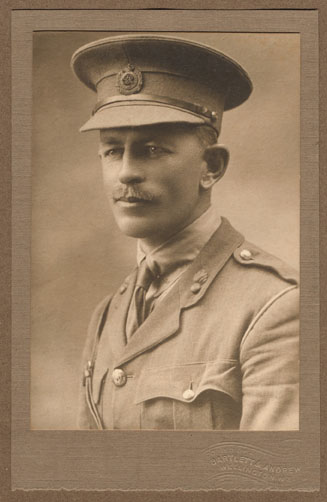

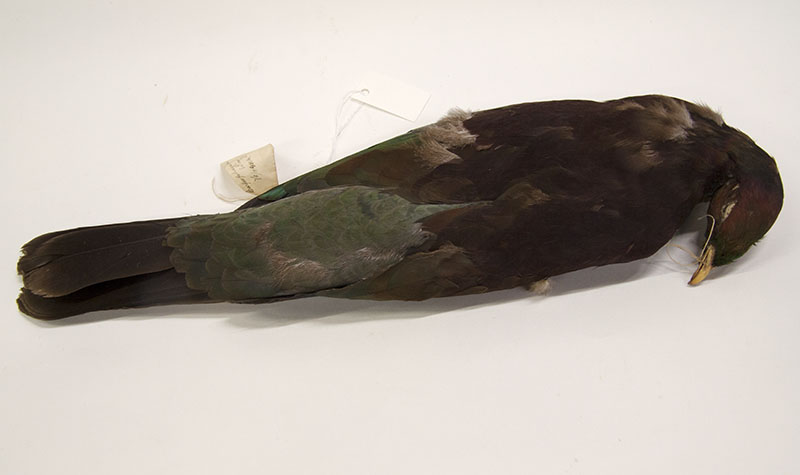
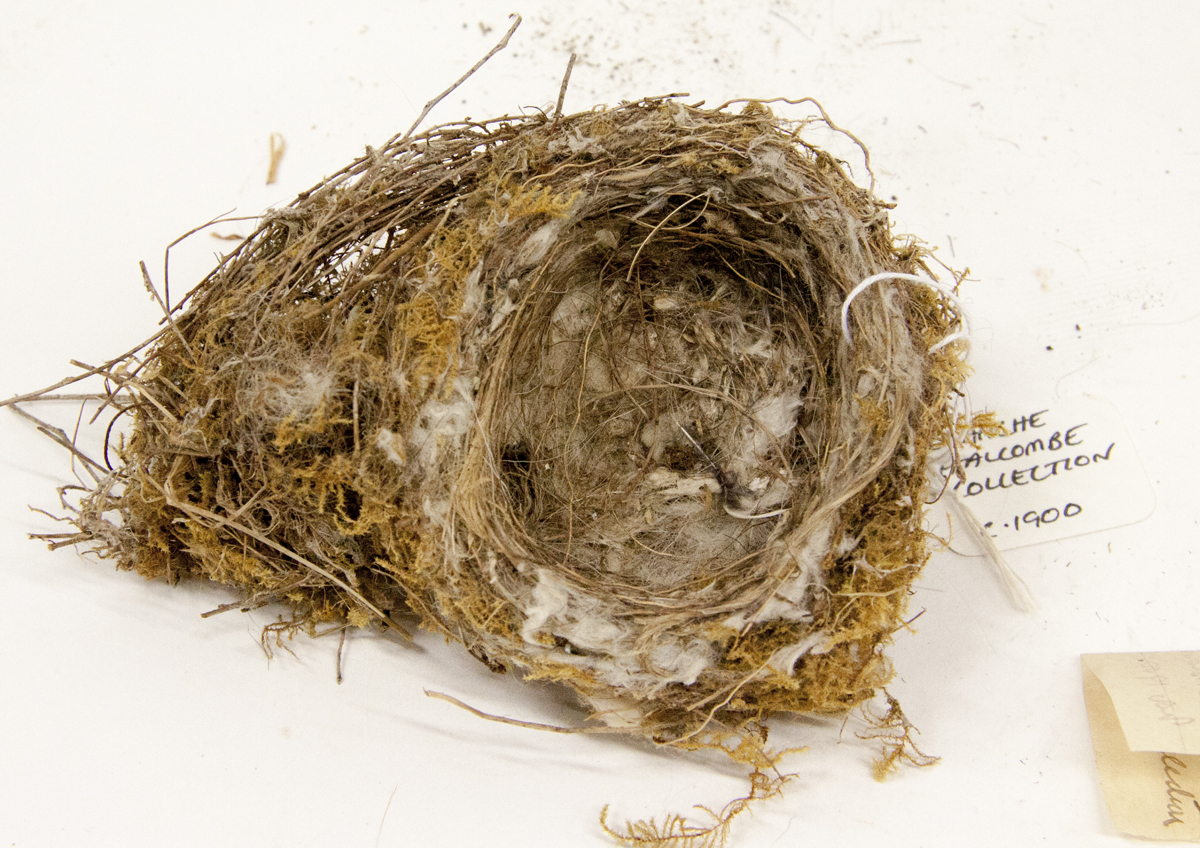
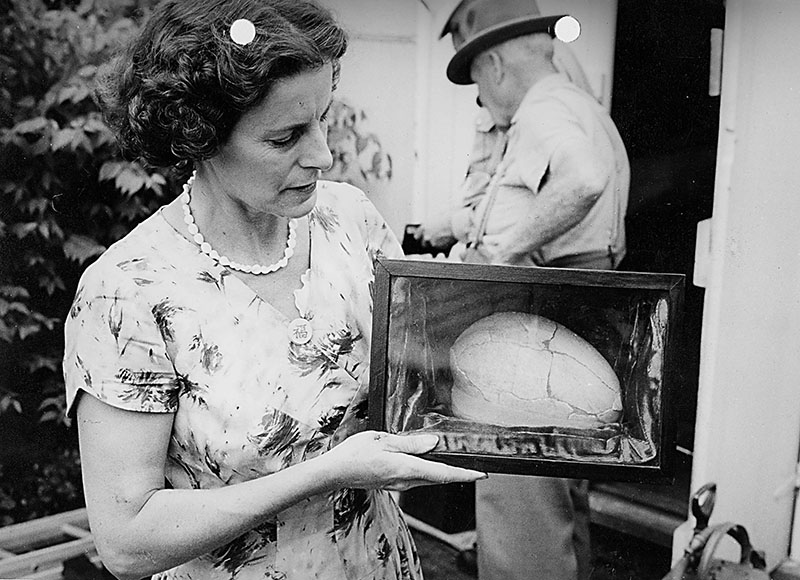

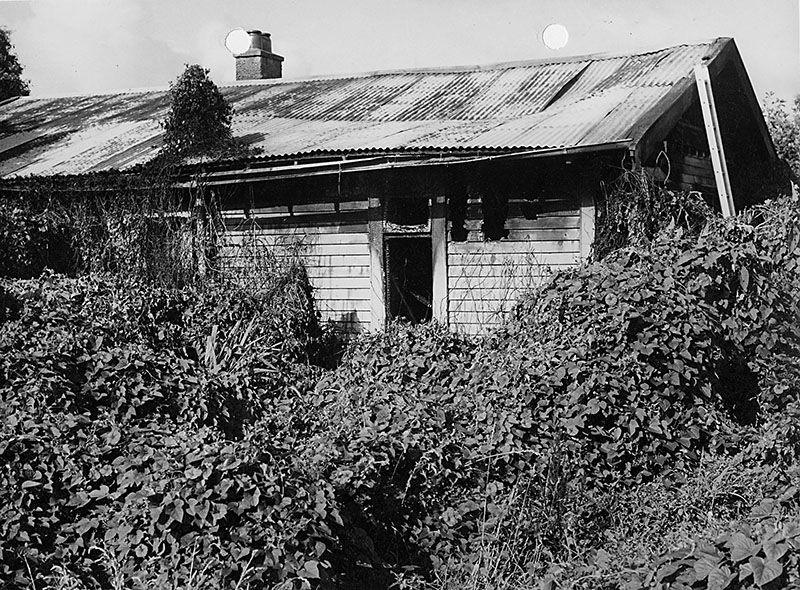
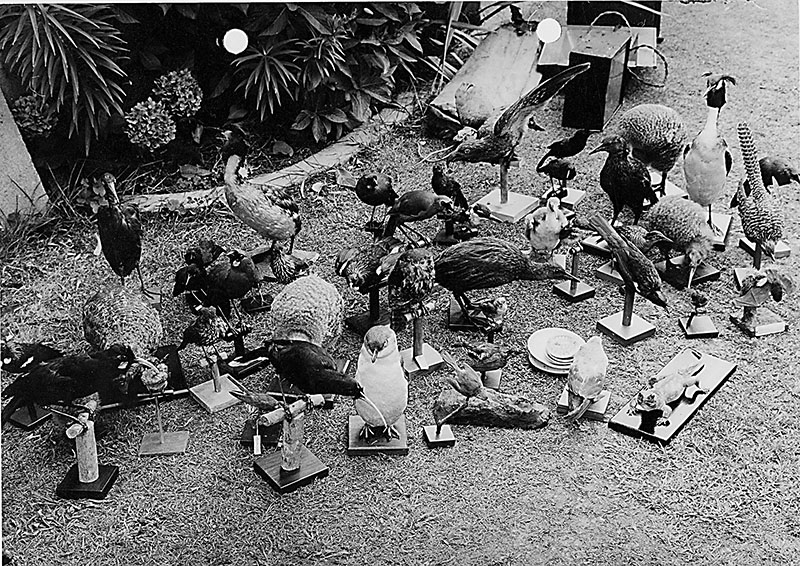
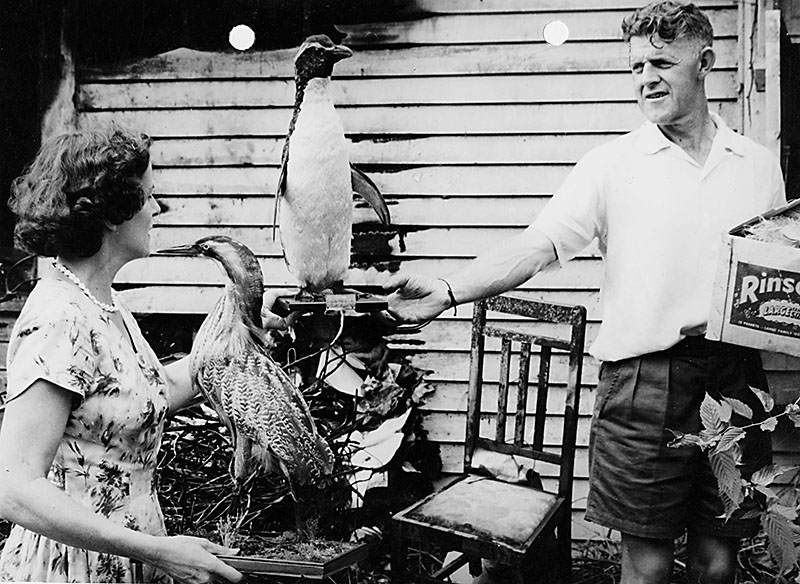
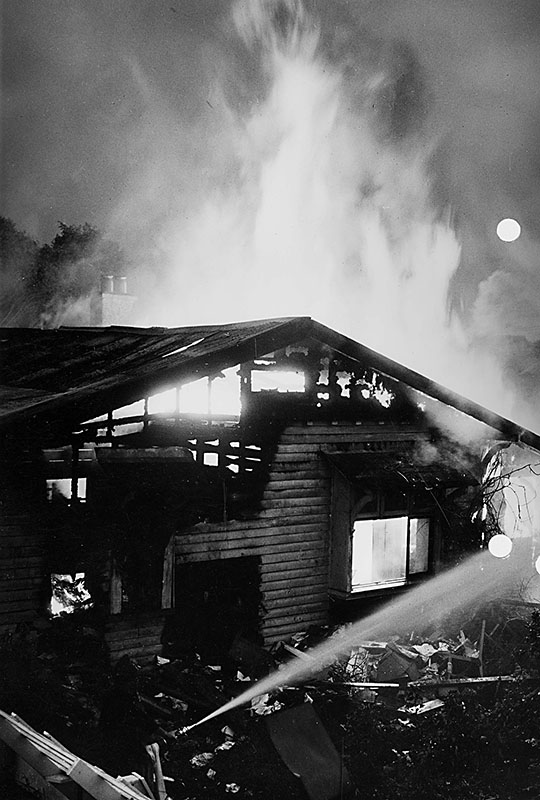
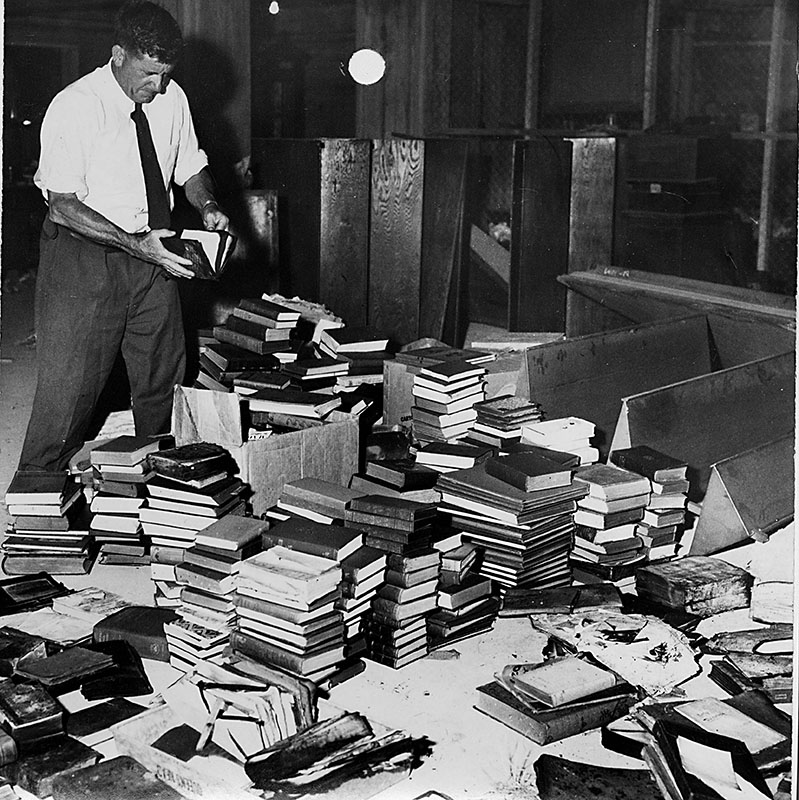
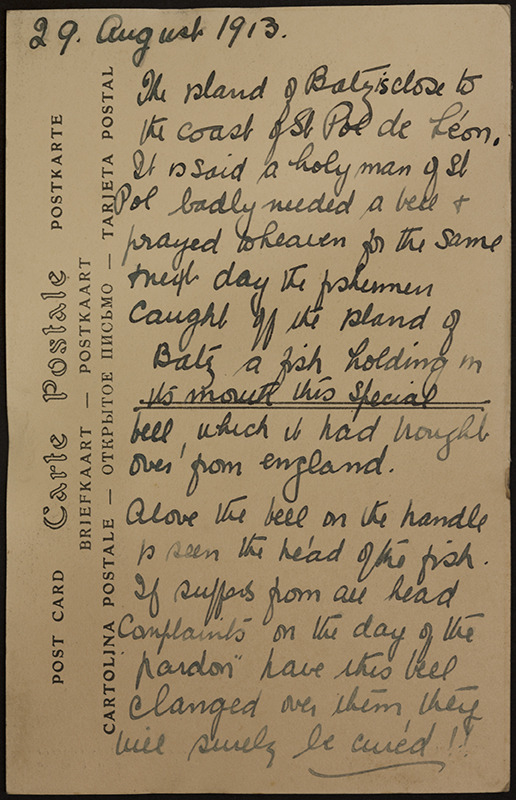
On 12 February 1961 fire fighters broke into a New Plymouth house and uncovered a fantastic story of treasure and tragedy. They revealed a sad tale of a woman who lived a strange and lonely existence guarding a collection of rubbish and rare and beautiful items.
On the 22 January 1919 at St Mary's Church Battersea, by the Reverand H. Foster. Pegg Norman Marshall Halcombe Major R.E and RAF, fourth son of Arthur and Edith Halcombe, Fern Grove, Urenui, New Zealand, to Blanche Sturt Turton, eldest daughter of Wesley and Amy Turton, Hawkeshead, Lake Wakatipu, New Zealand.
So began Blanche Halcombe's three week marriage to her husband Major Norman Halcombe - an engineer in the Royal Air Force during World War One. At age 38 she had found love, only for it to be ripped from her in a cruel twist of fate - her husband had survived the ravages of war to die in a deadly epidemic against which there was no defence. For Blanche it was the beginning of a 40 year downward spiral that would eventually lead to her death penniless and alone in a New Plymouth house.
Blanche was born in 1881. She was the daughter of Annette and Wesley Turton and came from a fine ‘upstanding’ family - her grandfather on her maternal side was William Swainson the naturalist and artist, and her paternal grandfather was Henry Hanson Turton, the missionary.
It was in this light that she grew up in the little township, with two sisters and three brothers. The Turton family would have been fairly well-to-do, her father was a solicitor. Not much is known about her childhood - where she went to school, who her friends were.
In 1910, aged 29, Blanche travelled to England as a lady's companion to a Miss Amy. Chirpy letters home reveal a young woman with a zest for life, enthusing over her new experiences - while based in London the pair travelled regularly - Jersey, Ireland, Scotland. "We're finally going to see the ceremony of the changing of the guard, I can't wait! I have heard so much about it and Amy and I are so looking forward to going." She wrote home every week, signing off with her pet name ‘Ba’.
It's in these letters, and her diary that her future husband Norman Halcombe is first mentioned. "Got a wire from Norman Halcombe, coming today, he arrived to lunch after which he took me and my cousin to Battersea Park…." And the next day: "Norman Halcombe and I sat in Paddington Gardens in the morning and ate sweets, afterwards we went to Kew Gardens" she wrote in a letter home dated 10 July 1915.
It wasn't until January 1919 when the Great War was over that Norman and Blanche married. It was a small wedding in the stone-clad St Mary's church at Battersea on the edge of the Thames River. The newlyweds had just one night together before Norman was shipped off to Marseilles.
“British Officers Club
24 January 1919
Dearest Girl,
It was so sweet and happy to know that you and I are really and truly belonging to each other that I did not feel tired a bit - but sad to leave you behind, sweetheart. But we will soon be together again and knowing that I just went off to sleep…
We leave for Marseilles tonight so I am hoping to get put on a boat going directly on to Bombay without the trans-shipment in Egypt.
It is bright and clear here and if only you sweetheart were here (and I had my keys) I would be quite happy.
Take care of yourself dearest and may you be ever so well and happy - with more love than I can tell you about.
Yours, lovingly
Norman.”
“76th Casualty Clearing Hospital
Port Said
7 February 1919
Dear Mrs Halcombe.
Your husband has just told me he would like me to write to you and tell you of his present condition. He developed influenza on board ship with slight lung symptoms and was disembarked and sent to us on the 5th.
He now has pneumonia I am sorry to say, but though his condition is, of course, critical and will be for some days, he is holding his own very satisfactorily and has a good strong pulse and is not in pain.
With sympathy for your present great anxiety,
Believe me
Yours sincerely J.N Wheeler
(Major R.A.M.C)”
“76th Casualty Clearing Hospital
18 February 1919
Dear Mrs Halcombe,
You have my greatest sympathy over the death of your husband.
I buried him in the Port Said cemetery which is quite a nice one surrounded on three sides by the sea. In a few weeks a cross will be put up. All the graves are covered in a green creeper - more of an ice plant than anything, with pretty daisy-like flowers…
With great sympathy for your loss,
Army Chaplain”
Like many war widows Blanche didn't get a body or grave to grieve over. Having her new husband die in some far off land and no way of getting to him must have been heart-breaking.
She left London soon after Norman's death and arrived in New Plymouth, where she lived with her mother at ‘The Peanut’ on Belt Road. It appears that Blanche and her mother lived frugally off the war pension that she received after Norman's death.
Like her grandfather Swainson, Blanche had a keen interest in natural history and ethnographical items - she would often disappear into the bush collecting specimens. Many of her explorations took place in the Waikawau and Nukuhakari districts - places in the back of beyond where secrets were waiting to be discovered. Laden with specimen box, tree climbing boots, sketch book and a camp stretcher she would disappear to likely haunts for days at a time. Kapiti Island was another favourite retreat where she would sit and sketch or wander through the bush looking for Māori artefacts or birds’ nests.
Puke Ariki houses some of the treasures she discovered: delicate little fantail nests made of grass, moss, twigs and rootlets, bound together with cobwebs and lined with hair; butterflies and bugs carefully pinned to cardboard and birds eggs carefully blown and kept in cotton wool.
Her interest in horticulture - revealed in her diaries and letters to friends - found an outlet in The Peanut's garden, and then in her Sanders Avenue garden. A prolific letter writer, Blanche would send letters off to ornithologists, natural historians and horticulturists around the world, asking for and giving advice.
The death of her brother Douglas in 1921, followed 15 months later by her father seemed to kick start a gradual decline in Blanche's mental and physical health. Her mother died just three years later in 1925. Gerald, the eldest of the Turton children, had been killed some years before in the Philippines, so Blanche was left with her brother Dick in Queenstown and two sisters who lived England and Ireland.
Notes and letters from the Puke Ariki archive show there was no love lost between the three sisters. By 1938 they were communicating only through the trustees of their father's estate: “I would like you to remind my sister Blanche that she owes me the sum of £12, I will not ask for interest to be paid on the amount but would like my money to be paid immediately” wrote one sister from Ireland.
Money seemed to be an ongoing problem - the siblings fought over their father's estate - and it appears Blanche eventually received very little. Her pension was very small and to survive on it she cut back on ‘extravagances’ and living frugally - even contemplating shifting into the garage and renting out her home.
From there the story just gets sadder. For years Blanche battled spinal arthritis - spending precious pension money on pain killers and ‘dreadful doctor's injections’. The pain from her back kept her at home, the worry from her situation and poor conditions brought on continuous bouts of shingles. As time went on she gradually withdrew herself from society, relying more on books and her collections for companionship. She cut herself off from friends and family - and eventually became a recluse.
Letters appeared to be Blanche's lifeline. After her death investigators found, in the jungle around her inaccessible home, a worn track to the letter box from the front door. She continued her prolific correspondence with authorities all over the world. She had a handful of friends who would write to her regularly - despite her desperate situation she appears to have put on a ‘face’ never revealing the situation she was in. No-one appeared to be aware of Blanche's dire state - even her neighbours.
In 1946 Blanche wrote to Prime Minister Peter Fraser asking for help with her pension. The long rambling letter written in a tight, almost indecipherable script reveals a woman in dire straits: “In desperation I write to you earnestly asking that by the time you read my letter you can decide what can be done. Unless some real relief is given me I will soon be homeless…
“The home I have been trying to buy since the Great War has meant daily sacrifices, giving up everything that makes life worth while living, disappearing out of friends lives, no holiday in all these years - the object being a home to live and die in. I wear second hand clothes a kindly rich friend has passes on to me. I hate it, and spend many hours a day feeling ashamed that I wasn't feeling glad of such a gift.”
Blanche described a trip to the Post Office to get her pension - only to find there was not enough to pay her bills: “It was impossible to meet rates, insurance - there was no money for food… I came out of the office sick with terror, turned down to the sea and my desperate mind suggested I walk into the sea and end all the agony of years and the fear of what will come next.” What sort of reply she got is unknown.
Blanche did get her wish for a new home - she moved into a four-roomed home on Sanders Avenue. But her beloved house, while providing a refuge, was also to become her prison and over time the condition of the property diminished - the garden became an overgrown jungle, inaccessible to all but the most determined.
Slowly the services were cut off - soon there was no electricity, no sewerage, no water - not that the taps in the house were accessible to use anyway. Blanche was known to get water from a nearby dairy where she shopped - mainly for canned goods, candles and fuel for her little primus stove that she cooked on.
She eventually barricaded herself into her own home after a visit from a concerned official and a policeman. Blanche ordered them both off the property and added extra precautions against other unwanted visitors by barricading the back door with wooden beams and rolls of wire netting. She padlocked windows and doors and added extra wire mesh over the windows of the rooms housing her collection.
When late one evening neighbours noticed smoke coming from the house there was no hope of Blanche escaping - she was trapped in her home made prison. Nor could anyone get in to rescue her. Firemen had to beat their way through the jungle garden before breaking into the house and wading through several feet of rubbish: papers, canned food, bric-a-brac, old mattresses, and books to get to the source of the fire. They made tracks, piling up the jumble on either side. But Blanche died in the ambulance on the way to hospital.
Taranaki Museum staff moved into her home and began the long task of sorting through the rubbish. Among the jumble and mess were hidden treasures - priceless articles bundled next to worthless rubbish. It was a strange mix of confusion and order for everything of museum or historic value was carefully catalogued: under an old mattress was a mahogany cabinet filled with bird’s eggs, all carefully identified and localised in Blanche's firm handwriting.
Original oil paintings and etchings by Frances Hodgkins, William Swainson and John Gully were heaped in piles on the floor. A set of exquisitely carved ivory chessmen, a moa egg, stuffed birds, and bird skins, although jumbled in with rubbish, were all neatly catalogued.
"Anything and everything might be discovered" wrote a Weekly News reporter: "Seeds were neatly packaged in brown paper bags, boxes of Ceylon tea, cases of tinned fruit, cocoa, coffee, tinned tongues and eggs, vitamin tablets by the score. Hundreds of reels of cottons, silks, knitting wool and buttons were found scattered about with chemistry sets and apothecary scales."
Many of Blanches treasures were destroyed - damaged either by fire or water. Those that were salvageable were sent to Auckland Museum or kept at the Taranaki Museum as Blanche had wished. Her house and all the accumulated rubbish was later razed to the ground.
It was only in death that Blanche came to the public's attention. Her intriguing story, along with pictures of an amazing collection made it into many national newspapers.
Please do not reproduce these images without permission from Puke Ariki.
Contact us for more information or you can order images online here.